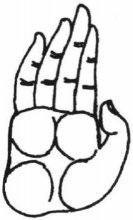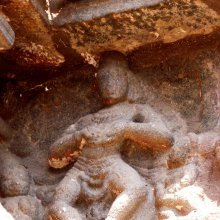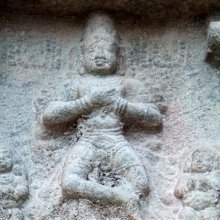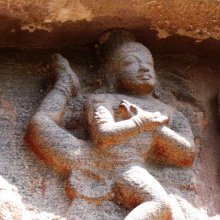Patakahasta, Patākahasta, Pataka-hasta: 3 definitions
Introduction:
Patakahasta means something in Hinduism, Sanskrit. If you want to know the exact meaning, history, etymology or English translation of this term then check out the descriptions on this page. Add your comment or reference to a book if you want to contribute to this summary article.
Images (photo gallery)
In Hinduism
Shilpashastra (iconography)
Source: Shodhganga: Vaisnava Agamas And Visnu ImagesPatākahasta (पताकहस्त) is another name for Abhayahasta (the “hand-gesture of fearlessness”), representing one of the various hand-poses (hastas or mudrās) defined in treatises such as the Pāñcarātra, Pādmasaṃhitā and Vaikhānasa-āgamas, extensively dealing with the technical features of temple art, iconography and architecture in Vaishnavism.—Abhayahasta conveys fearlessness and benign concept. This symbolizes the assurance of fearlessness, tranquillity and protection given by the deity to his worshipper. This hand pose is very common in the icons of Indian deities. The right hand, displayed palm outward with the fingers raised, remains turned towards the onlooker. Tills is mainly on the lower right hand. Abhayahasta is also referred to as Patākahasta.
Patākahasta is almost same as abhaya-mudrā but the hand kept away horizontally. Walker describes “the open palm upright, usually facing the spectator, fingers close together and pointing upward, thumb slightly bent inwards to touch the lower side of the forefinger”. (Accn. No .449/60 and 500/65). In some of the icons of the Museum, this hand is found treated as abhaya-mudrā and the lotus tern with small bud is inserted (Accn. No.3).

Shilpashastra (शिल्पशास्त्र, śilpaśāstra) represents the ancient Indian science (shastra) of creative arts (shilpa) such as sculpture, iconography and painting. Closely related to Vastushastra (architecture), they often share the same literature.
Natyashastra (theatrics and dramaturgy)
Source: Shodhganga: Elements of Art and Architecture in the Trtiyakhanda of the Visnudharmottarapurana (natya)Patākahasta (पताकहस्त) or simply Patāka refers to one of the twenty-two Asaṃyuktahastas or “single hand gestures” (in Indian Dramas), according to the Viṣṇudharmottarapurāṇa, an ancient Sanskrit text which (being encyclopedic in nature) deals with a variety of cultural topics such as arts, architecture, music, grammar and astronomy.—The hasta-mudrās (lit. “hand-gestures”) are very essential to denote some particular action or state in dancing and these mudrās are formed with the help of hands and fingers. In the Viṣṇudharmottarapurāṇa, twenty two kinds of asaṃyuktahastas (“dancing postures made only by single hand”) are mentioned. e.g., patākahasta.

Natyashastra (नाट्यशास्त्र, nāṭyaśāstra) refers to both the ancient Indian tradition (shastra) of performing arts, (natya—theatrics, drama, dance, music), as well as the name of a Sanskrit work dealing with these subjects. It also teaches the rules for composing Dramatic plays (nataka), construction and performance of Theater, and Poetic works (kavya).
Languages of India and abroad
Kannada-English dictionary
Source: Alar: Kannada-English corpusPatākahasta (ಪತಾಕಹಸ್ತ):—[noun] = ಪತಾಕ [pataka]2.
--- OR ---
Patākāhasta (ಪತಾಕಾಹಸ್ತ):—[noun] = ಪತಾಕ [pataka]2.
Kannada is a Dravidian language (as opposed to the Indo-European language family) mainly spoken in the southwestern region of India.
See also (Relevant definitions)
Partial matches: Hasta, Pataka.
Ends with: Ardhapatakahasta, Tripatakahasta.
Full-text (+15): Flag, Forest, River, Banner, Wind, Eagerness, Raining, Ketu, Blowing, Ugramurti, Pataka, Natural phenomenon, Siddhar, Balaramavatara, Haliramavatara, Cloud, Kalki, Prerita, Arana Valli, Candra.
Relevant text
Search found 3 books and stories containing Patakahasta, Patākahasta, Pataka-hasta, Patāka-hasta, Patākāhasta, Patākā-hasta; (plurals include: Patakahastas, Patākahastas, hastas, Patākāhastas). You can also click to the full overview containing English textual excerpts. Below are direct links for the most relevant articles:
Gati in Theory and Practice (by Dr. Sujatha Mohan)
Description of Gati in Abhinayadarpaṇa < [Chapter 2 - Concept and technique of Gati]
Elements of Āṅgika-abhinaya in Nāṭyaśāstra < [Chapter 1 - Nāṭya]
Gati used for the delineation of Bhāva and Rasa < [Chapter 3 - Application of gati in Dṛśya-kāvyas]
Vishnudharmottara Purana (Art and Architecture) (by Bhagyashree Sarma)
2.2. (d): Hand Gestures for Daśāvatāra < [Chapter 3 - Drama and Dance]
2.2. Hand Postures (a): Asaṃyukta-hasta < [Chapter 3 - Drama and Dance]
2.2. Hand Postures (b): Saṃyukta-hasta < [Chapter 3 - Drama and Dance]
The Religion and Philosophy of Tevaram (Thevaram) (by M. A. Dorai Rangaswamy)
Chapter 1.4 - Rishabharudha-murti (depiction of the Brahmani bull) < [Volume 2 - Nampi Arurar and Mythology]
Chapter 3.1 - Tripurantaka-murti (burning down of the three castles) < [Volume 2 - Nampi Arurar and Mythology]
Chapter 4.3 - (c) Sculptures of Shiva and Dance < [Volume 2 - Nampi Arurar and Mythology]



